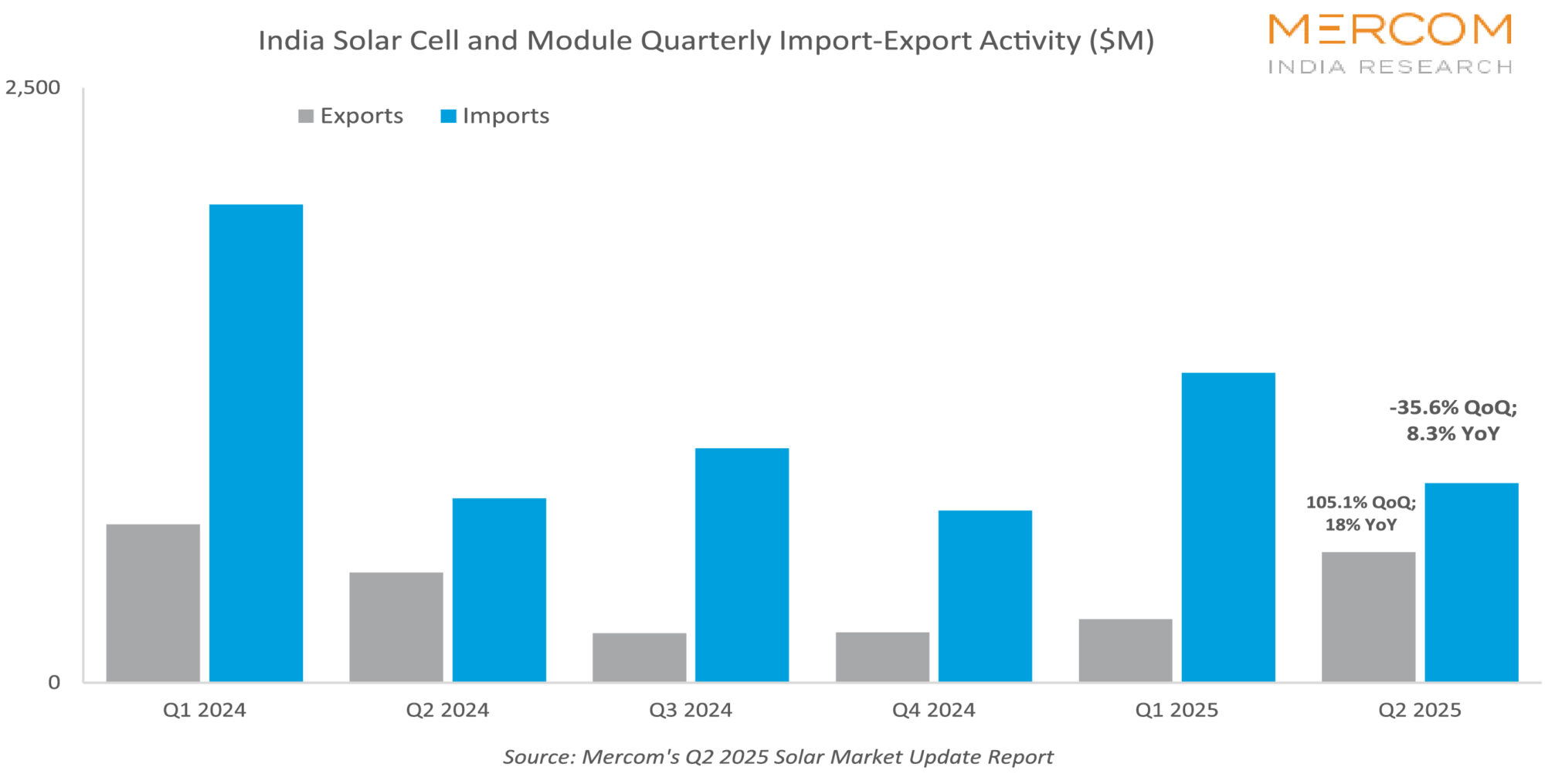India’s Solar Modules Imports Decreased Over 71% QoQ in Q2 2025
India’s solar exports rose 105.1% QoQ
September 18, 2025
Follow Mercom India on WhatsApp for exclusive updates on clean energy news and insights
India imported solar cells and modules worth over $839.4 million (₹71.9 billion) in Q2 2025, an 8.3% year-over-year (YoY) increase, according to data from the Department of Commerce.
Solar cells made up 72.4% of the total import value, while modules contributed the remaining 27.6%.
In a quarter-over-quarter (QoQ) comparison, module and cell imports dropped by 35.6% from over $1billion (~₹112.9 billion). While imports of solar cells rose 24.1%, imports of solar modules fell 71.5% from Q1 2025.
India’s solar cell and module imports fell QoQ. However, solar cell imports rose YoY as developers rushed to procure supplies, mainly from China, after the Ministry of New and Renewable Energy (MNRE) issued ALMM List-II for cells on August 1, 2025. Developers also secured purchases ahead of the September 1 exemption deadline.
Production-linked incentives and ALMM rules are expected to support domestic manufacturing and reduce dependence on imports, though module prices could remain elevated in the near term.
Recently, MNRE updated the ALMM by adding 8,797 MW of solar module manufacturing capacity.
In Q2 2025, 68.3% of the solar imports were from China, down 44% from the previous quarter.
Approximately 8.2% of solar imports were from Indonesia, followed by Vietnam, Ethiopia, and Singapore, with 8%, 5%, and 3.8%, respectively.
Government projects with bids submitted before September 1, 2025, are exempt from ALMM II compliance. From that date onward, all bids must include the cells listed in ALMM List II. Programs such as PM-KUSUM and PM Surya Ghar: Muft Bijli Yojana already mandate the use of DCR modules. Currently, only behind-the-meter projects can use imported modules and cells.
Exports
During Q2 2025, India exported solar cells and modules worth $549 million (₹46.9 billion), a 105.1% QoQ rise. Compared to the same period the previous year, solar exports increased by over 18%.
Solar module exports rose 106.3% QoQ, and cell exports rose by over 16%. Modules accounted for 99.3% of the quarter’s exports, while solar cells accounted for the remaining 0.7%.
The U.S. remained the top destination for solar exports from India, accounting for 96.2%.
Bangladesh, Kenya, Iran, and the UAE accounted for 3.3%, 0.2%, 0.1%, and 0.1% of the total exports, respectively.
High U.S. tariffs on solar imports from China, Vietnam, and other Southeast Asian countries prompted developers to seek new sourcing options. India emerged as a key alternative during the quarter due to its growing manufacturing capacity and the absence of such punitive tariffs.
Exports are likely to dip in the near term. Much will depend on how trade negotiations between the U.S. and India play out, and whether U.S. tariffs, currently at 50% under the Trump administration, are reduced. At this level, Indian solar exports risk losing their cost advantage and becoming less competitive for U.S. buyers. Exporters are already seeking alternatives to the U.S., with the European Union emerging as a potential option.
Indian solar exporters may face further challenges with the U.S. Department of Commerce initiating anti-dumping duty and countervailing duty investigations against imports of crystalline silicon photovoltaic cells, whether or not assembled into modules, from India, Indonesia, and Laos.
India added 25.3 GW of solar module capacity and 11.6 GW of solar cell capacity in 2024, according to Mercom’s State of Solar PV Manufacturing in India 2025 report.
Mercom’s India Solar EXIM Tracker provides detailed solar import and export data by component types, suppliers, manufacturers, and developers.
For an in-depth look at the data, analysis, and charts, subscribe to our quarterly market report, Mercom’s Q2 2025 India Solar Market Update.


